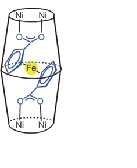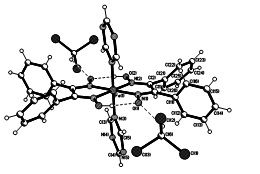Chemistry Journal of Moldova
Inorganic and coordination chemistry
Author(s):
Field: Inorganic and coordination chemistry
Type: Research paper
Issue: 2013 Volume 8, no.2
Pages: 78-82
Carolina Vomisescu, Paulina Bourosh, Victor Kravtsov, Diana Dragancea
Field: Inorganic and coordination chemistry
Type: Research paper
Issue: 2013 Volume 8, no.2
Pages: 78-82
Full Text (PDF): Download
DOI: dx.doi.org/10.19261/cjm.2013.08(2).09
Graphical Abstract: An ONO tridentate semicarbazone Schiff base and a bidentate dipyridyl ligand give a nickel(II) dimer, where atom centers are bridged by phenolate oxygen donors.
Downloads: 57
Author(s):
Field: Inorganic and coordination chemistry
Type: Research paper
Issue: 2013 Volume 8, no.2
Pages: 83-89
Viorina Gorinchoy, Sergiu Shova, Elena Melnic, Victor Kravtsov, ConstantinTurta
Field: Inorganic and coordination chemistry
Type: Research paper
Issue: 2013 Volume 8, no.2
Pages: 83-89
Full Text (PDF): Download
DOI: dx.doi.org/10.19261/cjm.2013.08(2).10
Graphical Abstract: A reaction of iron and barium nitrate with ammonium salicylate in the mixture of solvents leads to the formation of the new homotrinuclear complex, [Fe3O(SalH)7(H2O)2]∙(DMAA)2(MeOH)(THF)1,5(H2O)2,6. Single-crystal X-ray study shows that the titled complex with the moiety {Fe3O} belongs to the well-known group of μ3-oxohomotrinuclear carboxylates. The IR and MS studies are in accordance with x-ray data. Thermal behaviour of the complex was studied.
Downloads: 68
Author(s):
Field: Inorganic and coordination chemistry
Type: Research paper
Issue: 2013 Volume 8, no.1
Pages: 58-77
V. Lozan
Field: Inorganic and coordination chemistry
Type: Research paper
Issue: 2013 Volume 8, no.1
Pages: 58-77
Full Text (PDF): Download
DOI: dx.doi.org/10.19261/cjm.2013.08(1).08
Graphical Abstract: A series of novel tri-, tetra- and pentanuclear complexes composed of dinuclear LM units (M=Co, Ni, Zn; L=24-membered macrocyclic hexaaza-dithiophenolate ligand) and ferrocenecarboxylate ([CpFeC5H4CO2]ˉ), 1,1’-ferrocenedicarboxy-late ([Fe(C5H4-CO2)2]2ˉ), acetylene-dicarboxylate, terephthalate, isophthalate, and naphthalene diimide dicarboxylate groups is reported. The complexes, have been synthesized and characterised by UV/Vis-, IR-, NMR-spectroscopy, Cyclovoltammetry, and X-ray crystallography. Each dicarboxylate dianion acts as a quadridentate bridging ligand linking two bioctahedral LM2 units via µ1,3-bridging carboxylate functions to generate discrete dications with a central LM2(O2C-R-CO2)M2L core. The magnetic properties of these compounds reveal the presence of weak ferromagnetic exchange interactions between the NiII ions of the dinuclear subunits and negligible coupling across the dicarboxylate bridges.

Downloads: 37
Author(s):
Field: Inorganic and coordination chemistry
Type: Research paper
Issue: 2013 Volume 8, no.1
Pages: 78-82
О. Ciobanica, P. Bourosh, О. Bologa, I. Bulhac, V. Lozan, V. Shofransky
Field: Inorganic and coordination chemistry
Type: Research paper
Issue: 2013 Volume 8, no.1
Pages: 78-82
Full Text (PDF): Download
DOI: dx.doi.org/10.19261/cjm.2013.08(1).09
Graphical Abstract: The interaction of [Fe(DfgH)2Py2] (where DfgH=monodeprotonated diphenylglyioxime, Py-pyridune) and 1,3,5-triazine (Trz) in chloroform resulted in a new coordination compound with the composition [Fe(DfgH)2(Trz)2]·2CHCl3 (1). The crystal structure of 1, determined by single crystal X-ray diffraction, revealed that Fe(II) atom is coordinated by four oximic nitrogen atoms of two DfgH and two nitrogen atoms of two Trz ligands resulting in octahedral surrounding.

Downloads: 35
Author(s):
Field: Inorganic and coordination chemistry
Type: Research paper
Issue: 2012 Volume 7, no.2
Pages: 124-129
I. Voda, V. Druta, C. Indricean, I. Ciumacov, C. Turta
Field: Inorganic and coordination chemistry
Type: Research paper
Issue: 2012 Volume 7, no.2
Pages: 124-129
Full Text (PDF): Download
DOI: dx.doi.org/10.19261/cjm.2012.07(2).05
Graphical Abstract: By interaction of cobalt(II), nickel(II), or zinc(II) nitrate with 4,5- diphenylimidazole in methanol in solvotermal conditions the new derivative of imidazole (4,5-diphenyl-2-nitroimidazole) and three new coordinative compounds [M(4,5-Ph2ImNO2)2(CH3OH)2] have been synthesized and investigated. Metal ions have a distorted octahedral environment with N2O4. Coordination number of metal is six. Ligand is coordinated to metal ion by one oxygen atom of nitrogroup and one nitrogen atom of imidazole.
Downloads: 34
Author(s):
Field: Inorganic and coordination chemistry
Type: Review
Issue: 2010 Volume 5, no.1
Pages: 7-23
Vasile Lozan
Field: Inorganic and coordination chemistry
Type: Review
Issue: 2010 Volume 5, no.1
Pages: 7-23
Full Text (PDF): Download
DOI: dx.doi.org/10.19261/cjm.2010.05(1).01
Graphical Abstract: The coordination chemistry of dinickel macrocyclic
Downloads: 21
Author(s):
Field: Inorganic and coordination chemistry
Type: Review
Issue: 2010 Volume 5, no.1
Pages: 24-35
Vasile Lozan
Field: Inorganic and coordination chemistry
Type: Review
Issue: 2010 Volume 5, no.1
Pages: 24-35
Full Text (PDF): Download
DOI: dx.doi.org/10.19261/cjm.2010.05(1).02
Graphical Abstract: The steric protection offered by the macrobinucleating hexaazaditiophenolate
Downloads: 22
Author(s):
Field: Inorganic and coordination chemistry
Type: Research paper
Issue: 2010 Volume 5, no.1
Pages: 98-105
Gheorghe Nemtoi, Florica Ionica, Tudor Lupascu and Alexandru Cecal
Field: Inorganic and coordination chemistry
Type: Research paper
Issue: 2010 Volume 5, no.1
Pages: 98-105
Full Text (PDF): Download
DOI: dx.doi.org/10.19261/cjm.2010.05(1).10
Graphical Abstract: The dissolution of the iron from steel was observed by drawing the cyclic voltammetry (CV) for the systems consisting of the solution resulted when the alloy sample was immersed in HNO3, H2SO4, and HCl, aqueous solutions on platinum disk electrode (PtDE). The presence of some redox processes can be observed only in HNO3 which confirms the complexity of the mechanism of Fe dissolution in this acid. On the other hand, there were manufactured electrodes of steel samples taken into experiment achieving the corrosion characteristics in the media mentioned above.
Downloads: 23
Author(s):
Field: Inorganic and coordination chemistry
Type: Research paper
Issue: 2011 Volume 6, no.2
Pages: 70-72
Ştefan Manole, Maria Cocu
Field: Inorganic and coordination chemistry
Type: Research paper
Issue: 2011 Volume 6, no.2
Pages: 70-72
Full Text (PDF): Download
DOI: dx.doi.org/10.19261/cjm.2011.06(2).15
Graphical Abstract: We have researched the color properties of coordination compounds synthesized by us previously [1] (8-(1',2'-naphthyl)-1-
R3-methyl-6-thiomethyl-4,5,7-triazaocta-1,3,5,7-tetraenato-1,1'-diolato(-)O, O', N4, N7-M(II), where R=CH3, C6H5, M=Ni, Co, Cu), which can be used for coloring thermoplastic masses. They meet the requirements for use as a pigment for coloring thermoplastic masses.
Downloads: 33
Author(s):
Field: Inorganic and coordination chemistry
Type: Research paper
Issue: 2009 Volume 4, no.2
Pages: 68-71
S.B. Strashnova, O.V. Avramenko, M.N. Zhuk, O.V.Kovalchukova, P.V. Strashnov, B.E. Zaitsev
Field: Inorganic and coordination chemistry
Type: Research paper
Issue: 2009 Volume 4, no.2
Pages: 68-71
Full Text (PDF): Download
DOI: dx.doi.org/10.19261/cjm.2009.04(2).09
Graphical Abstract: The complexes of general formula MCl2∙L1-4∙nH2O (where L1 - N-(2,4,7-trinitrofluorenilidene-9)-p-dimethyl-aminoanilin, L2 - N-(2,4,5,7-tetranitrofluorenilidene-9)-p-dimethylaminoaniline, L3 - N-(2,4,7-trinitrofluorenilidene)-N-(p-dimethylaminophenyl)hydroxylamine, L4 - N-(2,4,5,7-tetranitrofluorenilidene-9)-N-(p-dimethylaminophenyl)-hydroxylamine; M=Cu, Co, Ni, Zn; n= 1-3 have been synthesized and investigated by different methods. Spectral criteria of co-ordination of the molecules L1 –L4 in electronic adsorption spectra were detected.
Downloads: 22






